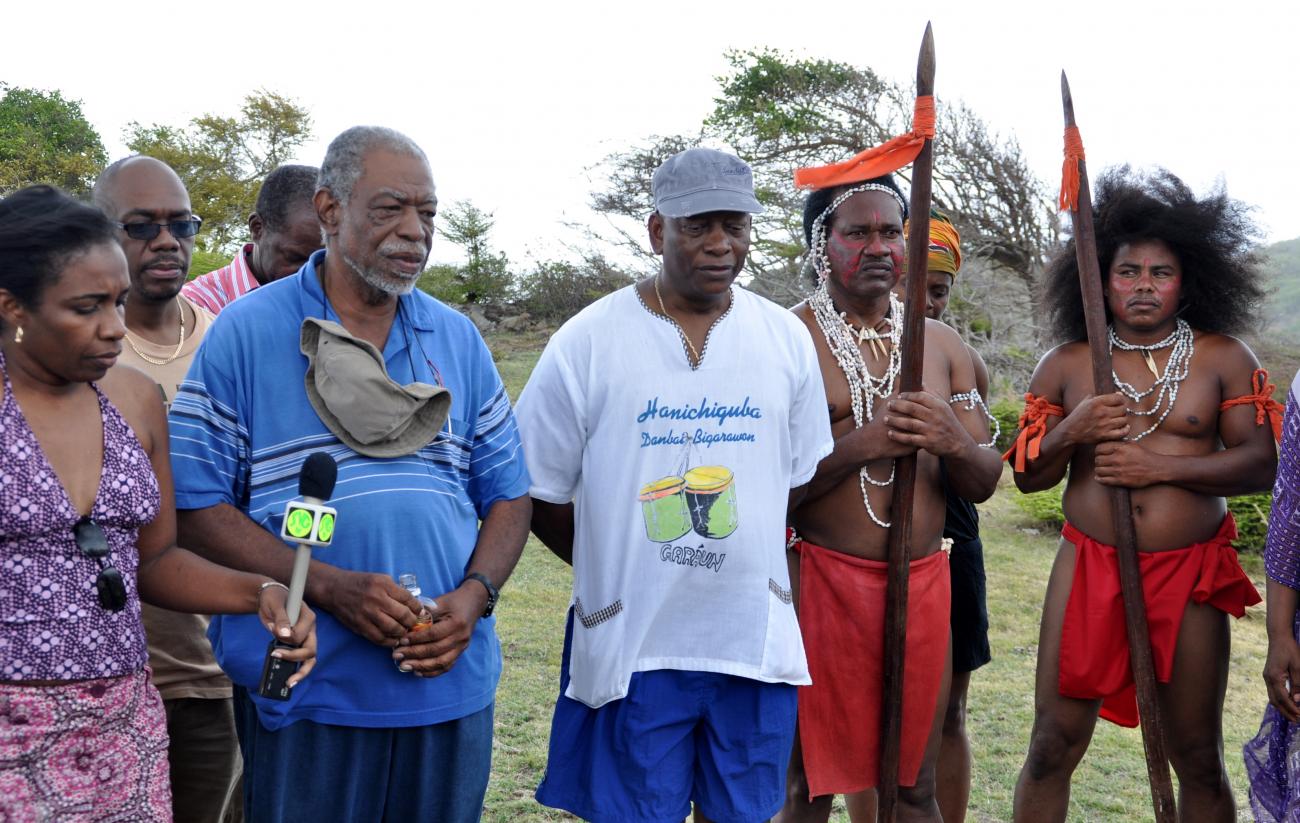
“Don’t forget your culture. If you lose your culture, you lose your identity. If you lose your identity, you don’t know where to go, ”--Armando Crisanto Melendez, Garifuna tradition bearer from Honduras
Honduran activist Melendez shouted this out across the stage in the small town of Sandy Bay, St. Vincent, West Indies. Hundreds of St. Vincent’s long-repressed Indigenous Garifuna community eagerly listened. Once labeled as “cannibals” by their British colonizers and shamed into denying their cultural ancestry for centuries, St. Vincent’s Afro-Indigenous Garifuna/Carib people had all but lost their Indigenous culture. Thankfully, this is all changing. Today, St. Vincent’s Garifuna are in full throes of a cultural revival. Garifuna from New York, Honduras, Belize, Los Angeles are visiting the home of their ancestors more regularly, bringing knowledge to their brothers and sisters who are so hungry for that cultural reconnection.
Award winning filmmaker Andrea Leland’s current project YURUMEIN (Our Homeland) is the untold first voice story of the Indigenous Carib/Garifuna people of St. Vincent. The film recounts their painful past, while building an intimate portrait of Garifuna culture-in-transition today. We see firsthand accounts from both Carib descendants in St. Vincent and the diaspora who unite in YURUMEIN to reinvigorate Garifuna culture on the island.
Los Angeles physician and Honorary Consul, Dr. Cadrin Gill, is a Carib from St. Vincent and returns to the island with the filmmaker. He very eloquently and passionately speaks of hardships the Caribs had to endure in both his generation and before. In an emotional memorial service on the nearby island of Balliceaux, the site of genocide 200 years ago at the hands of the British, Dr. Gill and others come together to remember, reflect and connect with spirit of the ancestors. With the help of their brothers and sisters in the diaspora, St. Vincent’s Garifuna begin to learn their ancestral language, music, dance and spirituality.
Through the power of film, Andrea Leland, a Caribbean-based documentary filmmaker, is contributing to the discussion, bringing “yurumein” to many who are unable to travel to St. Vincent and bringing much needed attention to the Carib/Garifuna descendants who live on St. Vincent today.
The idea to capture the Garifuna cultural renaissance in St. Vincent came to Leland in 2005 when she was invited to screen her film THE GARIFUNA JOURNEY (1998) on the island. The film, a former Special Project of Cultural Survival, explores present-day Garifuna culture in Belize, where the descendants of St. Vincent’s Garifuna were exiled after their defeat by the British in the 1790s. As THE GARIFUNA JOURNEY played in St. Vincent, the local Carib/Garifuna residents learned of the thriving Garifuna community that had survived outside of the homeland. On screen, they saw Garifuna culture, language and spirituality flourishing in the diaspora. At that moment, Leland says, “The Garifuna who had been living on St. Vincent became even more conscious of the disconnect between their lives and the history and ways of their ancestors. They were very emotional. ” Leland realized THE GARIFUNA JOURNEY only told the Garifuna experience from one angle and “the story of YURUMEIN began that very day.” The time is ripe for a Garifuna revival of St. Vincent’s indigenous culture on the island.
“They say Columbus discovered St. Vincent. You can’t discover a place when people are living here......we get that in school, but no that can’t be because the Carib was here ever since. So I can’t see how he discovered it when there were people living here," says Kendral Sam, a farmer living on St. Vincent.
Influenced by stories of cultural revitalization efforts among Native groups in the United States, St. Vincent’s Garifuna are just now learning about the communities in the diaspora where the culture had survived and in some places thrived. Revitalization of Garifuna culture was recognized internationally in 2001 when UNESCO awarded the Garifuna community the title, “Proclamation of Masterpieces of Oral and Intangible Heritage of Humanity.”
“When Indigenous people were here they tried to write their own history, they wrote it on stone, and in caves (petroglyphs). The next time around, they asked the persons who were there with them on the island to write it for them. And the English wrote their point of view. Now the time has come for those of us who are born in the West Indies. We are redefining the terms; we are almost re-writing history and certainly giving a different interpretation to what was there, and what was written before," says Doc Adams, a local historian.
Leland believes the story of YURUMEIN has the power to connect a people and culture that have been torn apart by brutal violence. YURUMEIN captures the struggles on St. Vincent to uncover the buried history of resistance, rupture and resilience of the Carib people. YURUMEIN gives Garifuna people worldwide the opportunity to reflect on what it means to be Garifuna today and what the legacy of colonialism has left behind.
To learn more about the YURUMEIN film project see http://www.cid.mimoona.com/Projects/477.
Like YURUMEIN on facebook and follow YURUMEIN on twitter.


